Amoebal endosymbiont Parachlamydia acanthamoebae Bn9 can grow in immortal human epithelial HEp-2 cells at low temperature; an in vitro model system to study chlamydial evolution
- PMID: 25643359
- PMCID: PMC4314085
- DOI: 10.1371/journal.pone.0116486
Amoebal endosymbiont Parachlamydia acanthamoebae Bn9 can grow in immortal human epithelial HEp-2 cells at low temperature; an in vitro model system to study chlamydial evolution
Abstract
Ancient chlamydiae diverged into pathogenic and environmental chlamydiae 0.7-1.4 billion years ago. However, how pathogenic chlamydiae adapted to mammalian cells that provide a stable niche at approximately 37 °C, remains unknown, although environmental chlamydiae have evolved as endosymbionts of lower eukaryotes in harsh niches of relatively low temperatures. Hence, we assessed whether an environmental chlamydia, Parachlamydia Bn9, could grow in human HEp-2 cells at a low culture temperature of 30 °C. The assessment of inclusion formation by quantitative RT-PCR revealed that the numbers of bacterial inclusion bodies and the transcription level of 16SrRNA significantly increased after culture at 30 °C compared to at 37 °C. Confocal microscopy showed that the bacteria were located close to HEp-2 nuclei and were actively replicative. Transmission electron microscopy also revealed replicating bacteria consisting of reticular bodies, but with a few elementary bodies. Cytochalasin D and rifampicin inhibited inclusion formation. Lactacystin slightly inhibited bacterial inclusion formation. KEGG analysis using a draft genome sequence of the bacteria revealed that it possesses metabolic pathways almost identical to those of pathogenic chlamydia. Interestingly, comparative genomic analysis with pathogenic chlamydia revealed that the Parachlamydia similarly possess the genes encoding Type III secretion system, but lacking genes encoding inclusion membrane proteins (IncA to G) required for inclusion maturation. Taken together, we conclude that ancient chlamydiae had the potential to grow in human cells, but overcoming the thermal gap was a critical event for chlamydial adaptation to human cells.
Conflict of interest statement
Figures
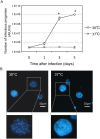
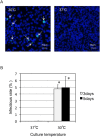
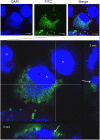

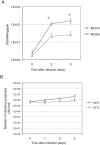
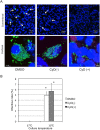
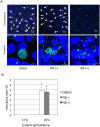
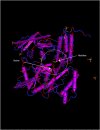
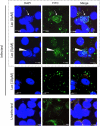
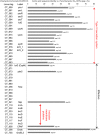
Similar articles
-
High-temperature adapted primitive Protochlamydia found in Acanthamoeba isolated from a hot spring can grow in immortalized human epithelial HEp-2 cells.Environ Microbiol. 2014 Feb;16(2):486-97. doi: 10.1111/1462-2920.12266. Epub 2013 Oct 6. Environ Microbiol. 2014. PMID: 24460765
-
Chlamydiae as symbionts in eukaryotes.Annu Rev Microbiol. 2008;62:113-31. doi: 10.1146/annurev.micro.62.081307.162818. Annu Rev Microbiol. 2008. PMID: 18473699 Review.
-
Amoebal host range, host-free survival and disinfection susceptibility of environmental Chlamydiae as compared to Chlamydia trachomatis.FEMS Immunol Med Microbiol. 2012 Apr;64(3):364-73. doi: 10.1111/j.1574-695X.2011.00919.x. Epub 2012 Jan 3. FEMS Immunol Med Microbiol. 2012. PMID: 22141597
-
Distribution of amoebal endosymbiotic environmental chlamydia Neochlamydia S13 via amoebal cytokinesis.Microbiol Immunol. 2021 Mar;65(3):115-124. doi: 10.1111/1348-0421.12871. Epub 2021 Feb 16. Microbiol Immunol. 2021. PMID: 33368645
-
[Environmental Chlamydiae with medical significance].Dtsch Med Wochenschr. 2011 Oct;136(41):2100-5. doi: 10.1055/s-0031-1292020. Epub 2011 Oct 4. Dtsch Med Wochenschr. 2011. PMID: 21971886 Review. German.
Cited by
-
Apoptosis Functions in Defense against Infection of Mammalian Cells with Environmental Chlamydiae.Infect Immun. 2020 May 20;88(6):e00851-19. doi: 10.1128/IAI.00851-19. Print 2020 May 20. Infect Immun. 2020. PMID: 32179584 Free PMC article.
-
Chlamydia vaughanii sp. nov., a novel Chlamydia isolated from a tropical fish (bushymouth catfish).Int J Syst Evol Microbiol. 2025 Jul;75(7):006753. doi: 10.1099/ijsem.0.006753. Int J Syst Evol Microbiol. 2025. PMID: 40632141 Free PMC article.
-
Temperature Affects the Host Range of Rhabdochlamydia porcellionis.Appl Environ Microbiol. 2023 May 31;89(5):e0030923. doi: 10.1128/aem.00309-23. Epub 2023 Apr 12. Appl Environ Microbiol. 2023. PMID: 37042763 Free PMC article.
-
Acanthamoeba containing endosymbiotic chlamydia isolated from hospital environments and its potential role in inflammatory exacerbation.BMC Microbiol. 2016 Dec 15;16(1):292. doi: 10.1186/s12866-016-0906-1. BMC Microbiol. 2016. PMID: 27978822 Free PMC article.
-
Lateral Gene Transfer Between Protozoa-Related Giant Viruses of Family Mimiviridae and Chlamydiae.Evol Bioinform Online. 2018 Jul 17;14:1176934318788337. doi: 10.1177/1176934318788337. eCollection 2018. Evol Bioinform Online. 2018. PMID: 30038484 Free PMC article.
References
Publication types
MeSH terms
LinkOut - more resources
Full Text Sources
Other Literature Sources
Molecular Biology Databases
Miscellaneous

